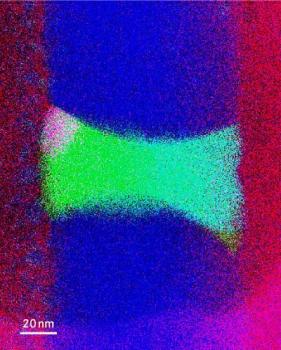Jul 24 2014
Researchers at the Helmholtz-Zentrum Dresden-Rossendorf (HZDR), the Vienna University of Technology and the Maria Curie-Skłodowska University Lublin have succeeded in embedding nearly perfect semiconductor crystals into a silicon nanowire.
 Indium arsenide (green-cyan) is perfectly integrated into the silicon nanowire (blue). (Energy-dispersive X-ray spectroscopy). Credit: HZDR/Prucnal
Indium arsenide (green-cyan) is perfectly integrated into the silicon nanowire (blue). (Energy-dispersive X-ray spectroscopy). Credit: HZDR/Prucnal
With this new method of producing hybrid nanowires, very fast and multi-functional processing units can be accommodated on a single chip in the future. The research results will be published in the journal Nano Research.
Nano-optoelectronics are considered the cornerstone of future chip technology, but the research faces major challenges: on the one hand, electronic components must be accommodated into smaller and smaller spaces. On the other hand, what are known as compound semiconductors are to be embedded into conventional materials. In contrast to silicon, many of such semiconductors with extremely high electron mobility could improve performance of the most modern silicon-based CMOS technology.
Scientists from the HZDR, Vienna University of Technology and Maria Curie-Skłodowska University Lublin have now come a step closer to both these targets: they integrated compound semiconductor crystals made of indium arsenide (InAs) into silicon nanowires, which are ideally suited for constructing increasingly compact chips.
This integration of crystals was the greatest obstacle for such "hetero-nanowires" until now: beyond the nanometer range, crystal lattice mismatch always led to numerous defects. The researchers have now managed a near-perfect production and embedding of the InAs crystals into the nanowires for the first time.
Implanted atoms form crystals in the liquid-phase
In order to carry out this process, ion beam synthesis and heat treatment with xenon flash-lamps were used, two technologies in which the Ion Beam Center of the HZDR has held experience for many years. The scientists initially needed to introduce a determined number of atoms precisely into the wires using ion implantation. They then carried out the flash-lamp annealing of the silicon wires in their liquid-phase within a matter of only twenty milliseconds. "A silicon oxide shell, measuring merely fifteen-nanometers-thick, maintains the form of the liquid nanowire," explains HZDR scientist Dr. Slawomir Prucnal, "while the implanted atoms form the indium-arsenide crystals."
Dr. Wolfgang Skorupa, the head of the research group adds: "The atoms diffuse in the liquid-silicon-phase so rapidly that within milliseconds they form flawless mono-crystals delineated from their surroundings with nearly perfect interfaces." In the next step, the scientists want to implement different compound semiconductors into Silicon nanowires and also optimize the size and distribution of the crystals.